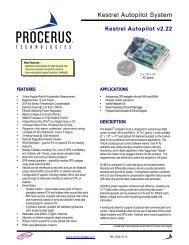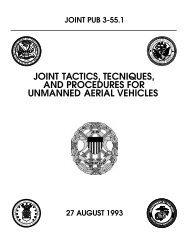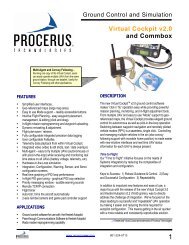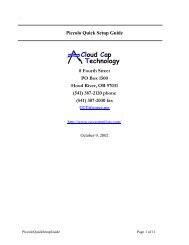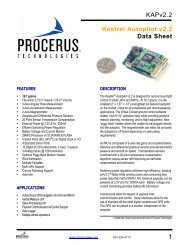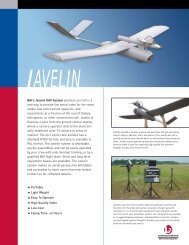Technology Cloud Cap - Unmanned Aircraft & Drones
Technology Cloud Cap - Unmanned Aircraft & Drones
Technology Cloud Cap - Unmanned Aircraft & Drones
Create successful ePaper yourself
Turn your PDF publications into a flip-book with our unique Google optimized e-Paper software.
<strong>Cloud</strong> <strong>Cap</strong><strong>Technology</strong>PO Box 1500, No 8 Fourth StreetHood River, OR 97031(541) 387-2120 ph (541) 387-2030faxPreflight checklist for the Piccolo system1. Turn on Piccolo and Ground Station, and launch the Operator Interface application.2. Verify and/or configure the ground station address list and pilot address.3. Verify working communications.4. Verify working aircraft GPS, check number of satellites and PDOP.5. Check and record initial battery voltage and current (typically 300mA at 12V).6. Configure map page as required by the mission.7. Configure flight plans as required by the mission, including lost comm flight plan.8. Verify correct autopilot gains, limits and trim settings (if known. i ).9. Verify correct mission limits including deadman status and lost comm waypoint.10. Set altimeter to local base pressure if known. ii11. Select manual control and verify manual control displayed in autopilot page.12. Verify control surface trims in manual mode. Adjust as necessary using the pilot console.13. Verify manual control, both magnitude and direction, for all control surfaces.14. Verify the reported control surfaces on the preflight page match the actual control positions.15. Check sensor readings and zero them if needed. iii16. Check the correct operation of the gyros and accelerometers by physically rotating theaircraft and verifying the sensor outputs iv .17. Verify that the pitot tube is clear by blowing into it and seeing the airspeed response.18. Configure the autopilot loops as needed, typically all loops on, with the waypoint setaccording to the overhead flight plan. Select manual control from the pilot console.19. Start the engine and verify correct operation through the entire RPM range. Check sensorreadings for signs of excessive noise due to engine vibration at different RPMs.20. Check communications at the far end of the runway strip. RSSI signal should indicate closeto the maximum reading (-71 dBm) v .21. Check for aircraft traffic and make any radio calls mandated by air traffic control.22. Determine the takeoff direction and set the initial waypoint in the event of lost comm.23. Final check on the system: Battery voltage and current, GPS health, RSSI, and sensors.24. Takeoff and start watch or timer.Piccolo <strong>Aircraft</strong> Integration Guidelines Page 18 of 20



